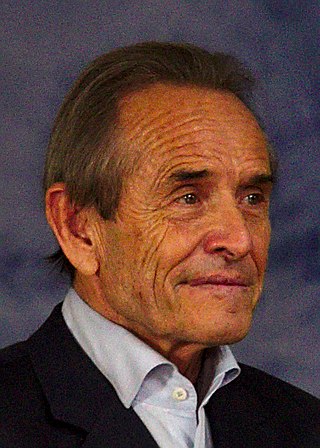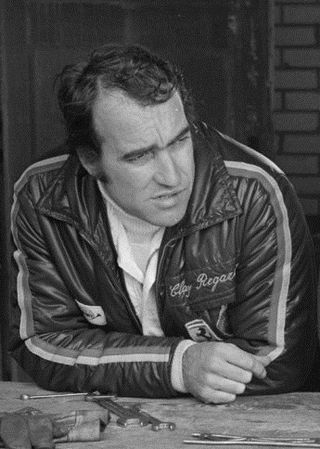
Andreas Nikolaus "Niki" Lauda was an Austrian Formula One driver and aviation entrepreneur. He was a three-time Formula One World Drivers' Champion, winning in 1975, 1977 and 1984, and is the only driver in Formula One history to have been champion for both Ferrari and McLaren, two of the sport's most successful constructors.

Karl Jochen Rindt was a German-born racing driver who competed with an Austrian license during his career, despite having German and not Austrian citizenship. In 1970, he was killed during practice for the Italian Grand Prix and became the only driver to be posthumously awarded the Formula One World Drivers' Championship.

Jacques Bernard Edmon Martin Henry "Jacky" Ickx is a Belgian former racing driver who won the 24 Hours of Le Mans six times and achieved eight wins and 25 podium finishes in Formula One. He greatly contributed to several World Championships for Makes and World Sports Car championships: Ford (1968), Ferrari (1972), Porsche (1976–1977) and (1982–1985) by his 37 major World Sports Car wins. He also won the Can-Am Championship in 1979 and the 1983 Paris–Dakar Rally.

The Canadian Grand Prix is an annual motor racing event held since 1961. It has been part of the Formula One World Championship since 1967. It was first staged at Mosport Park in Bowmanville, Ontario, as a sports car event, before alternating between Mosport and Circuit Mont-Tremblant, Quebec, after Formula One took over the event. After 1971, safety concerns led to the Grand Prix moving permanently to Mosport. In 1978, after similar safety concerns with Mosport, the Canadian Grand Prix moved to its current home at Circuit Gilles Villeneuve on Notre Dame Island in Montreal, Quebec.

The United States Grand Prix is a motor racing event that has been held on and off since 1908, when it was known as the American Grand Prize. The Grand Prix later became part of the Formula One World Championship. As of 2023, the Grand Prix has been held 52 times at ten different locations. Since 2012, it has been held every year at the Circuit of the Americas in Austin, Texas, except in 2020 when it was cancelled due to the COVID-19 pandemic.

The German Grand Prix was a motor race that took place most years since 1926, with 75 races having been held. The race has been held at only three venues throughout its history: the Nürburgring in Rhineland-Palatinate, Hockenheimring in Baden-Württemberg and occasionally AVUS in Berlin. The race continued to be known as the German Grand Prix, even through the era when the race was held in West Germany.

Bernard Charles Ecclestone is a British former business magnate. He is the former chief executive of the Formula One Group, which manages Formula One motor racing and controls the commercial rights to the sport. As such, he was commonly described in journalism as the 'F1 Supremo'.

The Italian Grand Prix is the fifth oldest national motor racing Grand Prix, having been held since 1921. Since 2013, it has been the Grand Prix held the most times, with 93 editions as of 2023. It is one of the two Grands Prix which has run as an event of the Formula One World Championship Grands Prix every season, continuously since the championship was introduced in 1950. Every Formula One Italian Grand Prix in the World Championship era has been held at Monza except in 1980, when it was held at Imola.

Eric Sidney Watkins, commonly known within the Formula One fraternity as Professor Sid or simply Prof, was an English neurosurgeon. Born in Liverpool, Watkins enrolled at the University of Liverpool where he graduated in 1952. He later served four years in the Royal Army Medical Corps before specialising in neurosurgery in Oxford and later, in London. Watkins also acted as a race track doctor at weekends which he continued at Watkins Glen International when he was appointed a Professor of Neurosurgery at State University of New York Upstate Medical University in Syracuse.

The 1984 Monaco Grand Prix was a Formula One motor race held at Monaco on 3 June 1984. It was race 6 of 16 in the 1984 FIA Formula One World Championship. It was the only race of the 1984 championship that was run in wet weather.

The 1985 Belgian Grand Prix was a Formula One motor race held at Spa-Francorchamps on 15 September 1985. It was the thirteenth round of the 1985 FIA Formula One World Championship. The race was the 43rd Belgian Grand Prix, the 31st to be held at Spa and the second since the circuit had been rebuilt and re-opened at half its original length in 1979. The race was held over 43 laps of the seven kilometre circuit for a total race distance of 301 kilometres.

Gianclaudio Giuseppe "Clay" Regazzoni was a Swiss racing driver. He competed in Formula One races from 1970 to 1980, winning five Grands Prix. His first win was the Italian Grand Prix at Monza in his debut season, driving for Ferrari. He remained with the Italian team until 1972. After a single season with BRM, Regazzoni returned to Ferrari for a further three years, 1974 to 1976. After finally leaving Ferrari at the end of 1976, Regazzoni joined the Ensign and Shadow teams, before moving to Williams in 1979, where he took the British team's first ever Grand Prix victory, the 1979 British Grand Prix at Silverstone.
Robert Brett Lunger is an American racecar driver.
Thomas Byrne is a former racing driver from Ireland. He participated in two Formula One Grands Prix in 1982 with the backmarker Theodore team, failing to qualify for another three. He failed to finish in either of the Grands Prix he started and scored no Formula One championship points.

The 1994 San Marino Grand Prix was a Formula One motor race held on 1 May 1994 at the Autodromo Enzo e Dino Ferrari, located in Imola, Italy. It was the third race of the 1994 Formula One World Championship. Michael Schumacher, driving for Benetton, won the race. Nicola Larini, driving for Ferrari, scored the first points of his career when he finished in second position. Mika Häkkinen finished third in a McLaren.
On 1 May 1994, Brazilian Formula One driver Ayrton Senna was killed after his car crashed into a concrete barrier while he was leading the 1994 San Marino Grand Prix at the Imola Circuit in Italy. The previous day, Austrian driver Roland Ratzenberger had died when his car crashed during qualification for the race. Several other collisions took place that weekend, including a serious one involving Rubens Barrichello. Ratzenberger and Senna's crashes were the first fatal accidents to occur during a Formula One race meeting since that of Riccardo Paletti at the 1982 Canadian Grand Prix, and were also the last until that of Jules Bianchi at the 2014 Japanese Grand Prix. This became a turning point in the safety of Formula One, prompting the implementation of new safety measures in both Formula One and the circuit, as well as the Grand Prix Drivers' Association to be reestablished. The Supreme Court of Cassation of Italy ruled that mechanical failure was the cause of the crash.

Jules Lucien André Bianchi was a French motor racing driver who drove for the Marussia F1 Team in Formula One.

Rush is a 2013 biographical sports film centred on the rivalry between two Formula One drivers, the Briton James Hunt and the Austrian Niki Lauda, during the 1976 motor-racing season. It was written by Peter Morgan, directed by Ron Howard and starred Chris Hemsworth as Hunt and Daniel Brühl as Lauda. The film premiered in London on 2 September 2013 and was shown at the 2013 Toronto International Film Festival before its United Kingdom release on 13 September 2013. The film received positive reviews from critics for Hemsworth and Brühl's performances, Howard's direction, the racing sequences, and Hans Zimmer's musical score.

There have been sixteen Formula One drivers from Austria including two winners of the World Drivers' Championship. Three Austrian drivers were killed while competing in the sport; only the United Kingdom has lost more racers' lives in the sport. Several others were seriously injured in competition, with some having career ending accidents.
















